The global clad pipe market is valued at USD 3.3 billion in 2025 and is slated to reach USD 5.6 billion by 2035, recording an absolute increase of USD 2.1 billion over the forecast period. This translates into a total growth of 66.3%, with the market forecast to expand at a compound annual growth rate (CAGR) of 5.5% between 2025 and 2035. The overall market size is expected to grow by nearly 1.7X during the same period, supported by increasing offshore oil and gas exploration activities, growing demand for corrosion-resistant materials, and rising adoption of advanced bonding technologies across diverse industrial piping applications.
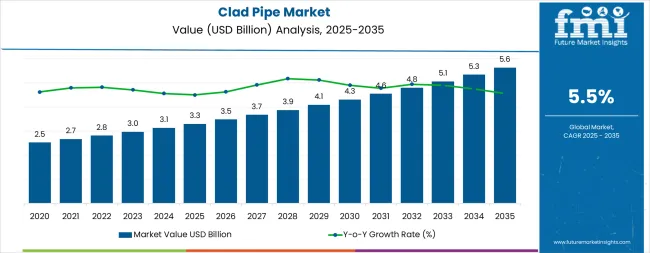
Between 2025 and 2030, the clad pipe market is projected to expand from USD 3.3 billion to USD 4.2 billion, resulting in a value increase of USD 0.9 billion, which represents 42.9% of the total forecast growth for the decade. This phase of development will be shaped by increasing offshore exploration projects, rising infrastructure investments in the oil and gas sector, and growing adoption of high-performance alloy solutions in chemical processing applications. Equipment manufacturers are expanding their production capabilities to address the growing demand for corrosion-resistant piping solutions and enhanced operational durability.
| Metric | Value |
|---|---|
| Estimated Value in (2025E) | USD 3.3 billion |
| Forecast Value in (2035F) | USD 5.6 billion |
| Forecast CAGR (2025 to 2035) | 5.5% |
From 2030 to 2035, the market is forecast to grow from USD 4.2 billion to USD 5.6 billion, adding another USD 1.2 billion, which constitutes 57.1% of the overall ten-year expansion. This period is expected to be characterized by the expansion of advanced bonding technologies, the integration of high-performance alloy systems, and the development of specialized piping solutions for major offshore and subsea projects. The growing adoption of corrosion-resistant infrastructure programs and advanced manufacturing initiatives will drive demand for clad pipes with enhanced performance characteristics and reduced maintenance complexity.
Between 2020 and 2025, the clad pipe market experienced steady growth, driven by increasing energy infrastructure development and growing recognition of clad piping as essential equipment for corrosion resistance and operational reliability. The market developed as oil and gas operators recognized the potential for advanced piping systems to enhance operational integrity while reducing maintenance costs and improving service life. Technological advancement in metallurgical bonding and explosive bonding technologies began emphasizing the critical importance of maintaining structural reliability and corrosion resistance in harsh operating environments.
Market expansion is being supported by the increasing offshore oil and gas exploration activities and the corresponding need for corrosion-resistant piping equipment that can maintain structural integrity and operational reliability while supporting diverse industrial applications across various harsh environments. Modern oil and gas operators are increasingly focused on implementing piping solutions that can reduce maintenance costs, minimize operational downtime, and provide consistent performance in high-pressure operations. Clad pipes' proven ability to deliver enhanced corrosion resistance, reliable structural capabilities, and versatile industrial applications make them essential equipment for contemporary offshore operations and chemical processing solutions.
The growing emphasis on infrastructure investment and operational efficiency is driving demand for clad pipes that can support high-pressure operations, reduce corrosion-related failures, and enable efficient fluid transport operations across varying industrial configurations. Industrial operators' preference for equipment that combines durability with corrosion resistance and cost-effectiveness is creating opportunities for innovative piping implementations. The rising influence of safety regulations and advanced manufacturing technologies is also contributing to increased adoption of clad pipes that can provide superior operational control without compromising performance or regulatory compliance.
The clad pipe market is poised for robust growth and transformation. As industrial operators across both developed and emerging markets seek piping equipment that is durable, corrosion-resistant, reliable, and operationally efficient, clad piping systems are gaining prominence not just as transport infrastructure but as strategic equipment for operational safety, cost reduction, service life enhancement, and regulatory compliance.
Rising offshore exploration and infrastructure investment in North America, Europe, and East Asia amplify demand, while manufacturers are picking up on innovations in metallurgical bonding and high-performance alloy technologies.
Pathways like advanced alloy adoption, bonding technology integration, and specialized application development promise strong margin uplift, especially in developed markets. Geographic expansion and application diversification will capture volume, particularly where offshore exploration is growing or industrial infrastructure requires modernization. Safety pressures around corrosion resistance, operational reliability, structural integrity, and regulatory compliance give structural support.
The market is segmented by pipe type, grade, wall thickness, end use, and region. By pipe type, the market is divided into metallurgical bonded (4 to 12 inch, 12 to 24 inch, 24 to 48 inch, above 48 inches), mechanically lined (4 to 12 inch, 12 to 24 inch, 24 to 48 inch, above 48 inches), and weld overlay (4 to 12 inch, 12 to 24 inch, 24 to 48 inch, above 48 inches). By grade, it covers 316L, 317L, Alloy 625, Alloy 825, and others. By wall thickness, it is segmented into 3 to 6 mm, 6 to 18 mm, 18 to 36 mm, 36 to 60 mm, and above 60 mm. By end use, it includes oil & gas, chemical & petrochemical, water treatment & desalination, power generation, mining & metallurgy, marine, and others. Regionally, the market is divided into North America, Latin America, Western Europe, Eastern Europe, East Asia, South Asia & Pacific, and Middle East & Africa.
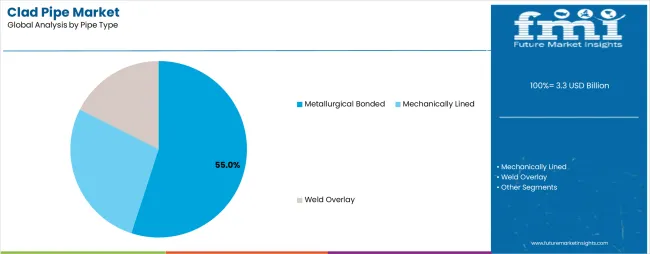
The metallurgical bonded segment is projected to account for 55.0% of the clad pipe market in 2025, reaffirming its position as the leading pipe type category. Industrial operators and energy companies increasingly utilize metallurgical bonded clad pipes for their superior welding properties, enhanced fabrication capabilities, and reliable structural integrity across oil and gas, chemical processing, and offshore applications. Metallurgical bonded pipe technology's established bonding procedures and consistent performance characteristics directly address the industrial requirements for reliable piping systems and operational efficiency in diverse industrial environments.
This pipe type segment forms the foundation of current industrial piping operations, as it represents the technology with the greatest structural reliability and proven fabrication compatibility across multiple applications and industrial scenarios. Operator investments in enhanced bonding systems and manufacturing optimization continue to strengthen adoption among oil and gas companies and chemical processors. With operators prioritizing structural integrity and fabrication efficiency, metallurgical bonded pipes align with both operational reliability objectives and cost management requirements, making them the central component of comprehensive industrial piping strategies.
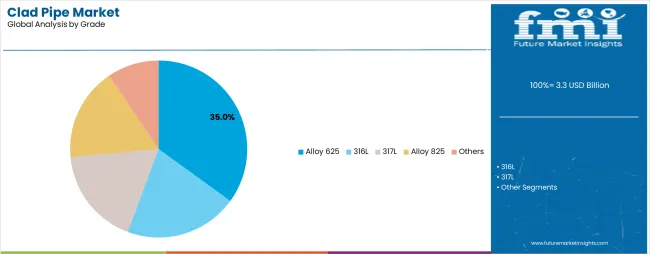
Alloy 625 is projected to represent 55.0% of clad pipe demand in 2025, underscoring its critical role as the primary grade selection for high-performance applications and corrosion-resistant industrial operations. Industrial operators prefer Alloy 625 clad pipes for their exceptional corrosion resistance, high-temperature capabilities, and ability to handle aggressive chemical environments while supporting critical infrastructure and operational requirements. Positioned as essential material for modern industrial applications, Alloy 625 offers both performance advantages and operational benefits.
The segment is supported by continuous innovation in alloy development and the growing availability of specialized grade configurations that enable efficient corrosion protection with enhanced operational capabilities. Industrial operators are investing in advanced material solutions to support large-scale operations and critical infrastructure delivery. As offshore operations become more prevalent and chemical processing requirements increase, Alloy 625 will continue to dominate the grade market while supporting advanced material utilization and industrial operational strategies.
The clad pipe market is advancing steadily due to increasing offshore oil and gas exploration and growing adoption of corrosion-resistant infrastructure that provides enhanced operational reliability and service life extension across diverse industrial applications. However, the market faces challenges, including high initial material costs, specialized fabrication requirements, and varying quality standards across different manufacturing environments. Innovation in metallurgical bonding and advanced alloy technologies continues to influence equipment development and market expansion patterns.
The growing expansion of offshore oil and gas operations and industrial infrastructure development is enabling equipment manufacturers to develop clad piping systems that provide superior corrosion resistance, enhanced structural capabilities, and reliable performance in high-pressure marine environments. Advanced clad piping systems provide improved operational durability while allowing more effective fluid transport and consistent service delivery across various applications and industrial requirements. Manufacturers are increasingly recognizing the competitive advantages of modern clad piping capabilities for operational efficiency and infrastructure longevity positioning.
Modern clad pipe manufacturers are incorporating metallurgical bonding and high-performance alloy systems to enhance corrosion resistance, reduce maintenance costs, and ensure consistent performance delivery to industrial operators. These technologies improve operational reliability while enabling new applications, including subsea pipeline systems and specialized chemical processing solutions. Advanced technology integration also allows manufacturers to support premium equipment positioning and performance optimization beyond traditional piping equipment supply.
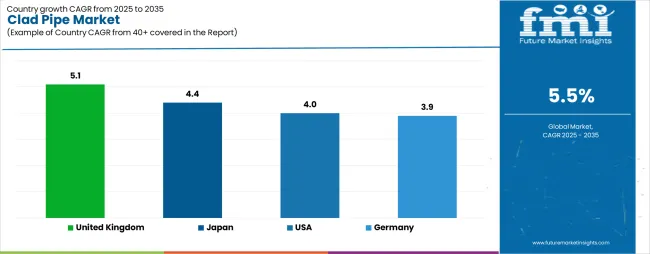
| Country | CAGR (2025-2035) |
|---|---|
| United Kingdom | 5.1% |
| Japan | 4.4% |
| United States | 4% |
| Germany | 3.9% |
The clad pipe market is experiencing steady growth globally, with ASEAN leading at a 6.2% CAGR through 2035, driven by extensive offshore oil and gas exploration projects, rapid industrial development, and significant adoption of corrosion-resistant piping solutions. UK follows at 5.1%, supported by marine sector expansion, advanced chemical processing facilities, and growing adoption of high-performance materials. Japan shows growth at 4.4%, emphasizing manufacturing excellence and advanced industrial capabilities. USA records 4%, focusing on offshore drilling operations and shale oil development. Germany demonstrates 3.9% growth, supported by advanced manufacturing capabilities and industrial modernization programs.
The report covers an in-depth analysis of 40+ countries, the top top-performing countries are highlighted below.
Revenue from clad pipes in United Kingdom is expanding at a CAGR of 5.1%, supported by the country's marine sector expansion, comprehensive chemical processing facilities, and increasing adoption of corrosion-resistant piping systems. The country's advanced industrial infrastructure and growing emphasis on operational reliability are driving sophisticated clad piping capabilities. Industrial operators and marine companies are establishing extensive piping operations to address the growing demand for corrosion protection and operational durability.
Revenue from clad pipes in Japan is expanding at a CAGR of 4.4%, supported by the country's advanced manufacturing capabilities, comprehensive industrial infrastructure, and extensive quality control programs among industrial operators. The nation's mature industrial sector and increasing emphasis on operational excellence are driving sophisticated clad piping capabilities throughout the equipment market. Leading manufacturers and industrial companies are investing extensively in advanced piping development and technology integration to serve both domestic industrial needs and export markets.
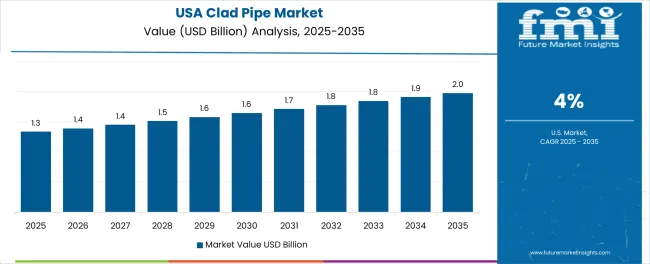
Revenue from clad pipes in United States is growing at a CAGR of 4%, driven by expanding offshore drilling operations, increasing shale oil development activities, and growing investment in energy infrastructure enhancement. The country's established energy sector and emphasis on operational efficiency are supporting demand for advanced clad piping technologies across major energy markets. Energy operators and industrial companies are establishing comprehensive piping programs to serve both domestic energy needs and operational reliability requirements.
Revenue from clad pipes in Germany is expanding at a CAGR of 3.9%, supported by the country's focus on advanced manufacturing capabilities, comprehensive industrial modernization programs, and strategic investment in operational efficiency improvement. Germany's established industrial infrastructure and emphasis on quality engineering are driving demand for specialized clad piping technologies focusing on operational reliability and manufacturing excellence. Industrial operators are investing in comprehensive piping modernization to serve both domestic industrial requirements and export market operations.
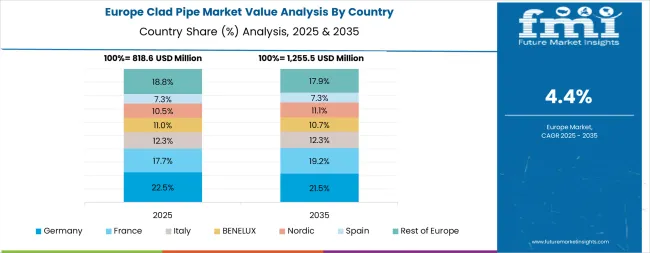
The clad pipe market in Europe is projected to grow from USD 0.8 billion in 2025 to USD 1.3 billion by 2035, registering a CAGR of 5.2% over the forecast period. Germany is expected to maintain its leadership position with a 32.1% market share in 2025, increasing to 32.8% by 2035, supported by its advanced industrial infrastructure, comprehensive manufacturing capabilities, and major chemical processing facilities serving European and international markets.
UK follows with a 28.4% share in 2025, projected to reach 28.9% by 2035, driven by marine sector expansion, offshore development programs, and established industrial capabilities, but facing challenges from competitive pressures and infrastructure investment constraints. France holds a 18.7% share in 2025, expected to decline to 18.2% by 2035, supported by chemical processing requirements and industrial modernization initiatives but facing challenges from regulatory adjustments and investment uncertainties. Italy commands a 12.6% share in 2025, projected to reach 12.8% by 2035, while Netherlands accounts for 8.2% in 2025, expected to reach 8.3% by 2035. The Rest of Europe region, including Nordic countries, Belgium, Switzerland, and other European countries, is anticipated to gain momentum, expanding its collective share from 8% to 8.5% by 2035, attributed to increasing industrial development across Nordic countries and growing infrastructure modernization across various European markets implementing advanced piping upgrade programs.
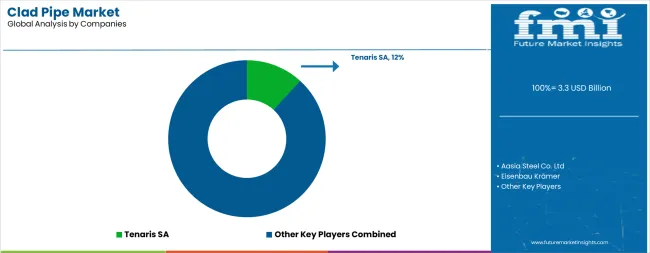
The clad pipe market is characterized by competition among established steel manufacturing companies, specialized clad piping technology providers, and integrated industrial equipment service companies. Companies are investing in advanced metallurgical bonding research, alloy development optimization, manufacturing process enhancement, and comprehensive piping portfolios to deliver durable, reliable, and high-performance clad piping solutions. Innovation in bonding technology systems, advanced alloy integration technologies, and specialized application capabilities is central to strengthening market position and competitive advantage.
Aasia Steel Co. Ltd leads the market with a strong presence, offering comprehensive clad piping solutions with a focus on metallurgical bonding and advanced manufacturing capabilities for oil and gas operations. Eisenbau Krämer provides specialized industrial piping portfolios with an emphasis on engineering excellence, customization capabilities, and project support services. EEW Group delivers integrated steel fabrication and clad piping solutions with focus on large-scale project execution and quality manufacturing. BUTTING Group specializes in stainless steel and clad piping systems with emphasis on offshore applications and marine environment compatibility. Gieminox Tectubi focuses on specialized industrial piping solutions with regional market leadership and technical expertise. Tenaris SA provides comprehensive pipe manufacturing capabilities with global service networks and integrated steel solutions.
| Items | Values |
|---|---|
| Quantitative Units (2025) | USD 3.3 billion |
| Pipe Type | Metallurgical Bonded (4 to 12 Inch, 12 to 24 Inch, 24 to 48 Inch, Above 48 Inches), Mechanically Lined (4 to 12 Inch, 12 to 24 Inch, 24 to 48 Inch, Above 48 Inches), Weld Overlay (4 to 12 Inch, 12 to 24 Inch, 24 to 48 Inch, Above 48 Inches) |
| Grade | 316L, 317L, Alloy 625, Alloy 825, Others |
| Wall Thickness | 3 to 6 mm, 6 to 18 mm, 18 to 36 mm, 36 to 60 mm, Above 60 mm |
| End Use | Oil & Gas, Chemical & Petrochemical, Water Treatment & Desalination, Power Generation, Mining & Metallurgy, Marine, Others |
| Regions Covered | North America, Latin America, Western Europe, Eastern Europe, East Asia, South Asia & Pacific, Middle East & Africa |
| Countries Covered | United States, Japan, Germany, United Kingdom, ASEAN countries, and 40+ countries |
| Key Companies Profiled | Aasia Steel Co. Ltd, Eisenbau Krämer, EEW Group, BUTTING Group, Gieminox Tectubi, Tenaris SA, and others |
| Additional Attributes | Equipment sales by type and grade category, regional demand trends, competitive landscape, technological advancements in bonding systems, alloy development, manufacturing innovation, and operational performance optimization |
The global clad pipe market is estimated to be valued at USD 3.3 billion in 2025.
The market size for the clad pipe market is projected to reach USD 5.6 billion by 2035.
The clad pipe market is expected to grow at a 5.5% CAGR between 2025 and 2035.
The key product types in clad pipe market are metallurgical bonded, mechanically lined and weld overlay.
In terms of grade, alloy 625 segment to command 35.0% share in the clad pipe market in 2025.






Full Research Suite comprises of:
Market outlook & trends analysis
Interviews & case studies
Strategic recommendations
Vendor profiles & capabilities analysis
5-year forecasts
8 regions and 60+ country-level data splits
Market segment data splits
12 months of continuous data updates
DELIVERED AS:
PDF EXCEL ONLINE
Key Players & Market Share in Clad Pipe Industry
Platycladus Orientalis Leaf Extract Market Size and Share Forecast Outlook 2025 to 2035
Laser Cladding Market Size and Share Forecast Outlook 2025 to 2035
Aluminum Cladding Market Size and Share Forecast Outlook 2025 to 2035
Rainscreen Cladding Market Growth - Trends & Forecast 2025 to 2035
High Power Double-Clad Fiber Bragg Grating Market Size and Share Forecast Outlook 2025 to 2035
High Frequency High Speed Copper Clad Laminate CCL Market Size and Share Forecast Outlook 2025 to 2035
USA & Canada Pre-painted Steel Roofing and Cladding Market Size and Share Forecast Outlook 2025 to 2035
Pipe Market Size and Share Forecast Outlook 2025 to 2035
Pipe Insulation Films Market Size and Share Forecast Outlook 2025 to 2035
Pipetting Robots Market Size and Share Forecast Outlook 2025 to 2035
Pipeline Monitoring System Market Size and Share Forecast Outlook 2025 to 2035
Pipeline Safety Market Size and Share Forecast Outlook 2025 to 2035
Pipe Insulation Market Size and Share Forecast Outlook 2025 to 2035
Pipe Wrenches Market Size and Share Forecast Outlook 2025 to 2035
Pipe Insulation Products Market Size and Share Forecast Outlook 2025 to 2035
Pipe Coatings Market Size and Share Forecast Outlook 2025 to 2035
Pipette Tips Market Size and Share Forecast Outlook 2025 to 2035
Pipe Screw Extruder Market Analysis - Size, Share, and Forecast Outlook 2025 to 2035
Pipette Controller Market – Trends & Forecast 2025 to 2035

Thank you!
You will receive an email from our Business Development Manager. Please be sure to check your SPAM/JUNK folder too.
Chat With
MaRIA